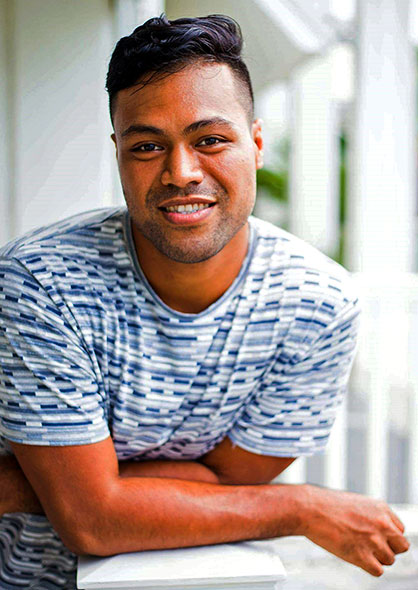The usual career trajectory for a new graduate from the School of Physiotherapy starts with a year or two in a busy hospital setting.

Otago graduate Mathew Amituanai factors chance into his early career direction as a physiotherapist.
A challenging start
Mathew arrived at Otago with the help of a scholarship from the New Zealand Government.
He had planned to study medicine but, unable to secure funding from the government at 'home' in Samoa, Mathew began to take a long hard look at physiotherapy. He knew little about the profession, but found himself drawn to the School's cross-disciplinary approach to learning, and its holistic patient care ethos.
Mathew returned to Samoa after graduation in 2012, and was almost immediately put in charge of the Medical Ward and of patient management on the island of Savaii. There, he soon found himself overwhelmed by the pressure of individual responsibility, the relative isolation, and the physical effort involved. After a few months, Mathew opted to take a short break which would soon lead to a new and unexpected career direction.
All points north
Stephen Betham, then coach of the Manu Samoan 7's rugby football team asked Mathew to come on board as part of the management team. Up to that point, the young physiotherapist had no plans for travel beyond his familiar home territories, and little interest in sport.
What followed was three years of global travel, with the clear purpose of helping his national team win every match.
Samoa draws its sportsmen and women from a total population of 180,000 yet often beats some of the best teams from the world's wealthiest nations. Mathew relished his work readying the team for tough competition rounds in such places as London, Las Vegas, Singapore, Paris, Dubai and Vancouver. He became accustomed to colleagues in physiotherapy asking him with a grin ... 'what happened?'
Home is where the heart is
After a time, each hotel room starts to look like the one before, and Mathew has returned to Samoa where he now works in the acute medical ward at Apia's Motootua Hospital. He divides his time between one role as physiotherapist in the acute medical ward three days a week, and another role, working the hospital's physiotherapy outpatient clinic on the remaining weekdays. Despite serving two distinct patient groups, all of his efforts revolve around physiotherapy.
Cultural factors add complexity to the profession of physiotherapy in Pacific nations. The discipline is still quite new in some areas and traditional healers still play a part at the village level. Some chronic conditions which may respond well to physiotherapy remain untreated.
Mathew feels that his experience with the Manu Samoa 7's team added perspective to his current hospital centred practice. Two physiotherapists serve the entire current population, so the need for critical thinking in clinical reasoning is paramount. Mathew feels that his role is to serve his country by caring for its people, knowing that like every player, each patient is a unique individual, and that effective therapy always fits within a broad and vital cultural, spiritual and community context.
Running the side-lines at Stade de France in Paris, or working through the daily patient list at the hospital in Apia, Mathew Amituanai's applied clinical skills reflect the best in contemporary physiotherapy and the profession's attention to individual patient well-being and quality of life in Pacific nations.
Mathew Amituanai graduated from the School of Physiotherapy in 2012 with a Bachelor of Physiotherapy (BPhty)
Read more about Health Science services for Pacifica people here
Publications
Lawrence, R. (2005). Branding terroir in the ′New World′: Modes of representation in the wine industry. In P. Sorrell, C. Ozcan, E. Kocabiyik & Z. T. Ultav (Eds.), Proceedings of the IST Product and Service Design Symposium and Exhibition on Agricultural Industries. Izmir, Turkey: Izmir University of Economics. [Full Paper] Conference Contribution - Published proceedings: Full paper